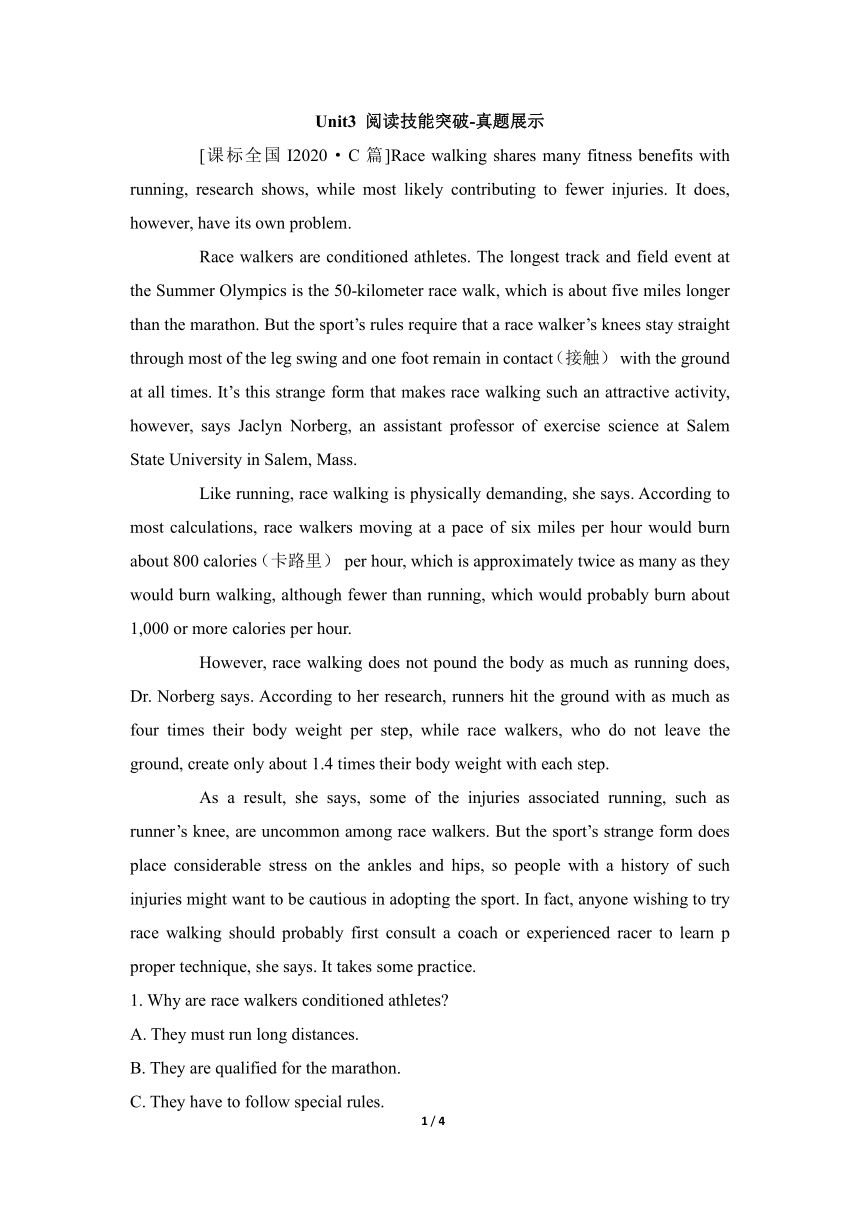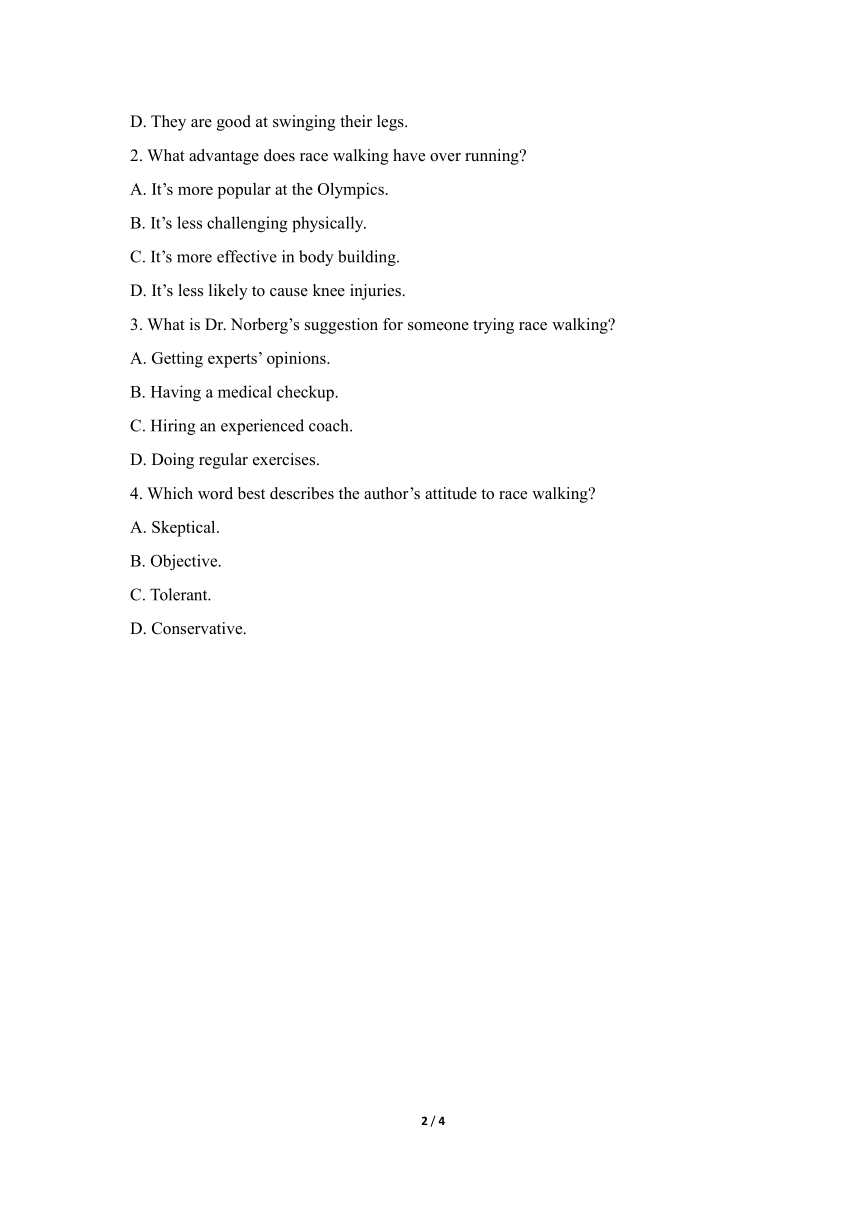外研版(2019)高中英语必修第二册 学案Unit3 On the move阅读技能突破-真题展示(Word版含解析)
文档属性
| 名称 | 外研版(2019)高中英语必修第二册 学案Unit3 On the move阅读技能突破-真题展示(Word版含解析) |  | |
| 格式 | docx | ||
| 文件大小 | 16.3KB | ||
| 资源类型 | 教案 | ||
| 版本资源 | 外研版(2019) | ||
| 科目 | 英语 | ||
| 更新时间 | 2023-02-26 22:05:59 | ||
图片预览


文档简介
Unit3 阅读技能突破-真题展示
[课标全国I2020·C篇]Race walking shares many fitness benefits with running, research shows, while most likely contributing to fewer injuries. It does, however, have its own problem.
Race walkers are conditioned athletes. The longest track and field event at the Summer Olympics is the 50-kilometer race walk, which is about five miles longer than the marathon. But the sport’s rules require that a race walker’s knees stay straight through most of the leg swing and one foot remain in contact(接触) with the ground at all times. It’s this strange form that makes race walking such an attractive activity, however, says Jaclyn Norberg, an assistant professor of exercise science at Salem State University in Salem, Mass.
Like running, race walking is physically demanding, she says. According to most calculations, race walkers moving at a pace of six miles per hour would burn about 800 calories(卡路里) per hour, which is approximately twice as many as they would burn walking, although fewer than running, which would probably burn about 1,000 or more calories per hour.
However, race walking does not pound the body as much as running does, Dr. Norberg says. According to her research, runners hit the ground with as much as four times their body weight per step, while race walkers, who do not leave the ground, create only about 1.4 times their body weight with each step.
As a result, she says, some of the injuries associated running, such as runner’s knee, are uncommon among race walkers. But the sport’s strange form does place considerable stress on the ankles and hips, so people with a history of such injuries might want to be cautious in adopting the sport. In fact, anyone wishing to try race walking should probably first consult a coach or experienced racer to learn p proper technique, she says. It takes some practice.
1. Why are race walkers conditioned athletes
A. They must run long distances.
B. They are qualified for the marathon.
C. They have to follow special rules.
D. They are good at swinging their legs.
2. What advantage does race walking have over running
A. It’s more popular at the Olympics.
B. It’s less challenging physically.
C. It’s more effective in body building.
D. It’s less likely to cause knee injuries.
3. What is Dr. Norberg’s suggestion for someone trying race walking
A. Getting experts’ opinions.
B. Having a medical checkup.
C. Hiring an experienced coach.
D. Doing regular exercises.
4. Which word best describes the author’s attitude to race walking
A. Skeptical.
B. Objective.
C. Tolerant.
D. Conservative.
答案:
【语篇导读】本文主要通过将竞走与跑步进行对比的方式,介绍了竞走的基本规则、对竞走者体能的要求及竞走对身体的冲击力,并给想要尝试竞走的人提出了一些建议。
1. C推理判断题。根据题干中的conditioned athletes可定位至文章第二段。根据第二段第三句But the sport’s rules require that a race walker’s knees stay straight through most of the leg swing and one foot remain in contact with the ground at all times.可知,这项运动的规则要求竞走者在大部分摆动腿的过程中,膝盖要保持笔直,一只脚要始终与地面接触。由此可推知,竞走者需要是受过训练的运动员,这是因为他们必须遵守特殊的规则,故选C项。
2. D细节理解题。根据最后一段第一句中的some of the injuries associated with running, such as runner’s knee, are uncommon among race walkers可知,跑步时常见的膝盖受伤在竞走者中是很少见的。由此可知,这是竞走相对于跑步而言的一个优势。故选D项。
【微技能】如何收集细节信息
做英语阅读的细节理解题时,常用方法如下:
(1)顺序原则
一般来说隐含细节理解题目答案的位置与题目的顺序是一致的,这能帮助我们缩小寻找范围,大大提高效率。我们做题可采用步步为营法,看一题做一题。
(2)利用定位词
定位词和主题句是英语阅读理解解题方法最重要的两个要素,前者适用于解答细节理解题,后者适用于解答主旨大意题。通过定位词解题,需要我们在阅读题干的时候迅速把题干中有标记意义的词或词组标记出来,然后用这个词回到文中定位。
什么词才算是定位词呢?我们首先要关注的是人名、地名等专有名词以及题干中出现的大写的名词和表示年份、数量、百分数的数词。如果题干中没有以上提到的定位词,我们则需要留意一些表示实体意义或指代一件具体事物的具象名词。
3. A细节理解题。根据最后一段倒数第二句中的anyone wishing to try race walking should probably first consult a coach or experienced racer to learn proper technique可知,诺伯格博士建议,想要尝试竞走的人都应该首先咨询教练或有经验的运动员来学习恰当的技巧,即应得到专业人士的建议,故选A项。
4. B推理判断题。通读全文可知,作者在本文中分别阐述了竞走的好处(Race walking shares many fitness benefits with running)及其存在的问题(It does, however, have its own problem.),提及正反两方面,由此可推知,作者的态度是客观的。故选B项。
2 / 2
[课标全国I2020·C篇]Race walking shares many fitness benefits with running, research shows, while most likely contributing to fewer injuries. It does, however, have its own problem.
Race walkers are conditioned athletes. The longest track and field event at the Summer Olympics is the 50-kilometer race walk, which is about five miles longer than the marathon. But the sport’s rules require that a race walker’s knees stay straight through most of the leg swing and one foot remain in contact(接触) with the ground at all times. It’s this strange form that makes race walking such an attractive activity, however, says Jaclyn Norberg, an assistant professor of exercise science at Salem State University in Salem, Mass.
Like running, race walking is physically demanding, she says. According to most calculations, race walkers moving at a pace of six miles per hour would burn about 800 calories(卡路里) per hour, which is approximately twice as many as they would burn walking, although fewer than running, which would probably burn about 1,000 or more calories per hour.
However, race walking does not pound the body as much as running does, Dr. Norberg says. According to her research, runners hit the ground with as much as four times their body weight per step, while race walkers, who do not leave the ground, create only about 1.4 times their body weight with each step.
As a result, she says, some of the injuries associated running, such as runner’s knee, are uncommon among race walkers. But the sport’s strange form does place considerable stress on the ankles and hips, so people with a history of such injuries might want to be cautious in adopting the sport. In fact, anyone wishing to try race walking should probably first consult a coach or experienced racer to learn p proper technique, she says. It takes some practice.
1. Why are race walkers conditioned athletes
A. They must run long distances.
B. They are qualified for the marathon.
C. They have to follow special rules.
D. They are good at swinging their legs.
2. What advantage does race walking have over running
A. It’s more popular at the Olympics.
B. It’s less challenging physically.
C. It’s more effective in body building.
D. It’s less likely to cause knee injuries.
3. What is Dr. Norberg’s suggestion for someone trying race walking
A. Getting experts’ opinions.
B. Having a medical checkup.
C. Hiring an experienced coach.
D. Doing regular exercises.
4. Which word best describes the author’s attitude to race walking
A. Skeptical.
B. Objective.
C. Tolerant.
D. Conservative.
答案:
【语篇导读】本文主要通过将竞走与跑步进行对比的方式,介绍了竞走的基本规则、对竞走者体能的要求及竞走对身体的冲击力,并给想要尝试竞走的人提出了一些建议。
1. C推理判断题。根据题干中的conditioned athletes可定位至文章第二段。根据第二段第三句But the sport’s rules require that a race walker’s knees stay straight through most of the leg swing and one foot remain in contact with the ground at all times.可知,这项运动的规则要求竞走者在大部分摆动腿的过程中,膝盖要保持笔直,一只脚要始终与地面接触。由此可推知,竞走者需要是受过训练的运动员,这是因为他们必须遵守特殊的规则,故选C项。
2. D细节理解题。根据最后一段第一句中的some of the injuries associated with running, such as runner’s knee, are uncommon among race walkers可知,跑步时常见的膝盖受伤在竞走者中是很少见的。由此可知,这是竞走相对于跑步而言的一个优势。故选D项。
【微技能】如何收集细节信息
做英语阅读的细节理解题时,常用方法如下:
(1)顺序原则
一般来说隐含细节理解题目答案的位置与题目的顺序是一致的,这能帮助我们缩小寻找范围,大大提高效率。我们做题可采用步步为营法,看一题做一题。
(2)利用定位词
定位词和主题句是英语阅读理解解题方法最重要的两个要素,前者适用于解答细节理解题,后者适用于解答主旨大意题。通过定位词解题,需要我们在阅读题干的时候迅速把题干中有标记意义的词或词组标记出来,然后用这个词回到文中定位。
什么词才算是定位词呢?我们首先要关注的是人名、地名等专有名词以及题干中出现的大写的名词和表示年份、数量、百分数的数词。如果题干中没有以上提到的定位词,我们则需要留意一些表示实体意义或指代一件具体事物的具象名词。
3. A细节理解题。根据最后一段倒数第二句中的anyone wishing to try race walking should probably first consult a coach or experienced racer to learn proper technique可知,诺伯格博士建议,想要尝试竞走的人都应该首先咨询教练或有经验的运动员来学习恰当的技巧,即应得到专业人士的建议,故选A项。
4. B推理判断题。通读全文可知,作者在本文中分别阐述了竞走的好处(Race walking shares many fitness benefits with running)及其存在的问题(It does, however, have its own problem.),提及正反两方面,由此可推知,作者的态度是客观的。故选B项。
2 / 2
